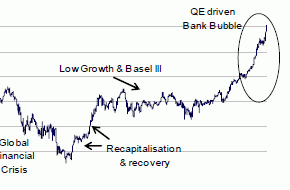
Sydney-based UBS banking analysts created a stir last week with a research report entitled 'Welcome to the great bank bubble of 2013'.
The chart heavy report cautions readers about the high valuations placed on the big four Australian banks ANZ Bank Group, Commonwealth Bank of Australia, National Australia Bank and Westpac Banking Corporation. The four own New Zealand's ASB, ANZ, BNZ and Westpac.
The UBS report follows on from previous similarly themed reports from the same analysts, Jonathan Mott, Chris Williams and Adam Lee, albeit they previous ones were more narrowly focused on the biggest of the Australian banks, CBA. They issued a report in January entitled 'Everything has a price. Downgrade to Sell'. And another in August last year entitled 'One bank for the price of three'.
In an interview with CBA's CEO Ian Narev in March we asked him about the bank's high market capitalisation of more than A$100 billion. Here's the full story from the interview and below are a couple of Narev's quotes.
"There are clearly forces in the equity markets at the moment that suit the profile of our stock, which is globally there is a low interest rate environment, you've got investors searching for yield. They're searching for yield with equity stocks with defensive characters."
"CBA and the other major banks in Australia are attractive. That is creating a dynamic underpinning the performance of the stock at the moment. Do we expect that dynamic to continue for ever? Of course not. Can I say when it's going to end, what's going to happen after it? I don't know and you can't manage the bank to that."
And here's the UBS report from Mott, Williams and Lee;
Welcome to the great bank bubble of 2013
The Australian banks are some of the strongest in the world
The Aussie banks are very good companies. They are profitable, resilient, well capitalised, well managed, shareholder focused and have a very strong industry and regulatory structure. However, following the significant leveraging of the Australian & NZ households over the last thirty years they are now low growth and remain heavily exposed to housing, funding markets & unemployment risk.
Banking sector has hit a record high PE of 14.9x
We are conscious of the bull case for Aussie banks and all ‘yield’ stocks: further Quantitative Easing; rate cuts; falling term deposits (TDs) rates; asset allocation flows into equities; the ‘least worst investment’; value of franking credits. However, bank dividends are a result of significant leverage; they are not annuities comparable to TDs. It must be noted Aussie banks are trading on a record (price to earnings multiple) PE of 14.9x (CBA is on 16x).
A lower discount rate leads to lower ROE and lower dividends
Some argue that banks should trade at a higher multiple given a lower cost of capital. However, if banks reduce their view of their cost of capital from 11-12% to around 9% (as market is implying) this will lead the banks to bid more aggressively for business, lower net interest margins (NIMs) and eventually produce a lower return on equity (ROE) and dividends. This has already been seen overseas.
Lower growth also implies more volatility in impairments and a higher beta. This is a valuation ‘circular reference’.
The boy who cried ‘wolf’?
As with all asset bubbles, they can go higher and for longer than many expect. With a solid near term earnings outlook there is nothing stopping the market bidding dividend yields in to ~4.5% (historical lows) implying about 10% share price upside. As Chuck Prince (former CEO of Citigroup) famously said “As long as the music is playing, you’ve got to get up and dance”.
All we can say is buyer beware.
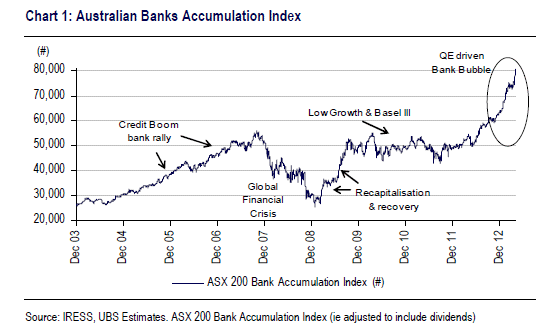
Over the last 10 years we have seen one of the largest resources booms in history and a Global Financial Crisis. Despite this Aussie banks have now outperformed the resources sector during this period.
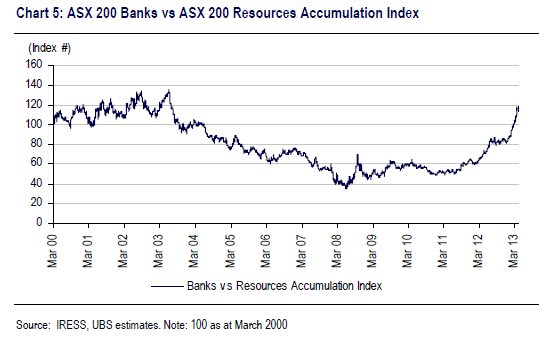
All four Aussie major banks are now in the world’s top 11 banks by market capitalisation.
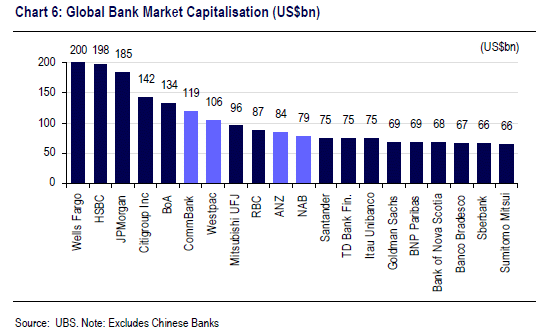
All of the Aussie banks look extremely expensive when compared to global peers.
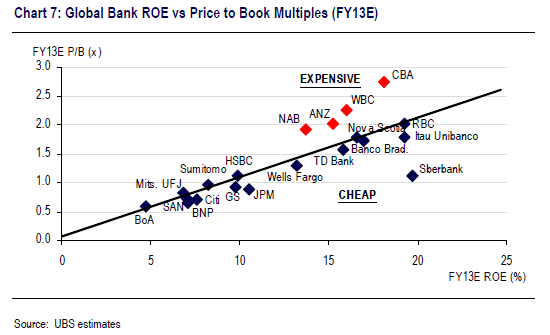
Banks dividend yields are cheap relative to term deposit rates, although we see this as a fundamentally flawed comparison.
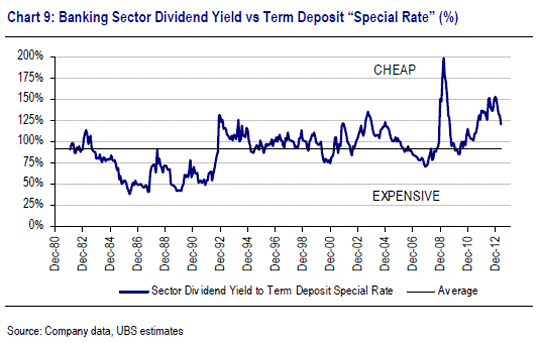
Bank earnings yields versus government bond yields are also cheap given the impact of quantitative easing.
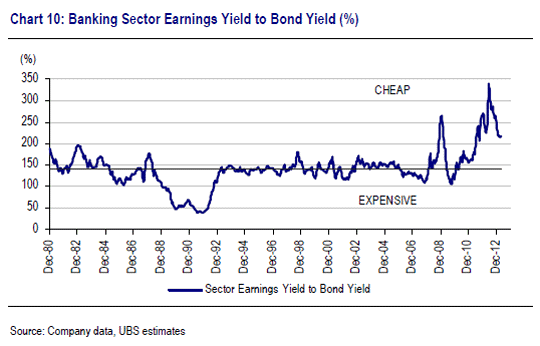
4 Comments
Who is the guest writer?
Have a look at a chart of BHP overlaid over CBA
BHP represents the resource engine that has driven the economy since 2004
On that pretty picture you will see that since the beginning of 2008
BHP has fallen -20%
CBA has risen 60%
Are the banks overvalued. Probably
Have the banks been extracting protected profits out of the Australasian economies
The pretty picture tells the story
Yep good article Gareth.........at least some confirmation of large scale exposure is out there in the public arena now,....although...Narev said you never say never.
"(But) we stress the mortgage book to 13% unemployment (it's currently 5.4%) and a 40% drop in property values. We are very comfortable still with the level of losses that does. Now all models have got potential flaws. You never know what you don't know. But against any foreseeable scenarios, driven by a hard landing in China, freezing up of credit markets, all those sorts of things, we are comfortable that we can withstand the shock," said Narev.
You never know what you don't know..? The whole concept of scenario building is to set the parameters to the improbables....imagine the unexpected, but totaly real possibility of being blindsided,..........so I was not entirely convinced he was truthful there, or do they just let opimists run amok over at the CBA....?
Yes , I think their valuations are inflated, reflecting the very nature of the speculative market they have chosen to become major underwriters of. Narev aknowledges as much when he considers the possibility of exposure shock and their percieved ability to withstand the losses.
I would imagine here in N.Z. the OBR now does away with the RBNZ's continuing Bank principal of the eighties.......
People get ready as I am under no illusions our Parent bankers would spread the load, or maximise losses to focused subsiduaries.
Whats happening at the end, is the CEO will walk away with a lot whatever happens.
Surely some of the profits should be put towards reducing leverage?
And risk.
For government, shareholders and bondholders
It is clearly too big to fail and should be broken up.

We welcome your comments below. If you are not already registered, please register to comment
Remember we welcome robust, respectful and insightful debate. We don't welcome abusive or defamatory comments and will de-register those repeatedly making such comments. Our current comment policy is here.